Cathelicidins - Study guides, Class notes & Summaries
Looking for the best study guides, study notes and summaries about Cathelicidins? On this page you'll find 46 study documents about Cathelicidins.
Page 2 out of 46 results
Sort by

-
NR507 Final exam Study Guide1.
- Exam (elaborations) • 21 pages • 2023
-
- $11.49
- + learn more
. Types of immunity-e.g. innate, active, etc (ch 7 ,191) Innate immunity includes two lines of defense: natural barriers and inflammation Natural barriers are physical, mechanical, and biochemical barriers at the body’s surfaces and are in place at birth to prevent damage by substances in the environment and thwart infection by pathogenic microorganisms. the natural epithelial barrier and inflammation confer innate resistance and protection, commonly referred to as innate, native,...
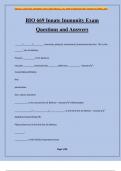
-
BIO 669 Innate Immunity Exam Questions and Answers
- Exam (elaborations) • 46 pages • 2024
-
- $12.49
- + learn more
BIO 669 Innate Immunity Exam Questions and Answers ______/_______/_________ immunity: physical, mechanical, biochemical barriers. This is the _______ line of defense Prevent __________ from bacteria Includes ________, chemicals like _______, defensins, _________ - Answer- Innate/Natural/Native first penetration skin, sweat, lysozyme ___________ is the second line of defense - Answer-inflammation ______________/_____________/_____________ is the third line of defense - Answer- Adaptiv...
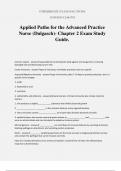
-
Applied Patho for the Advanced Practice Nurse (Dulgasch)- Chapter 2 Exam Study Guide.
- Exam (elaborations) • 2 pages • 2024
-
- $10.49
- + learn more
Applied Patho for the Advanced Practice Nurse (Dulgasch)- Chapter 2 Exam Study Guide. Immune system - answerresponsible for protecting the body against microorganisms, removing damaged cells and destroying cancer cells Innate Immunity - answertype of immunity; immediate protection and non specific Acquired/Adaptive Immunity - answertype of immunity; takes 7-10 days to provide protection, but it is specific to the antigen 1. acidic 2. Hydrochloric acid 3. Lysozyme 4. cathelicidins and ...
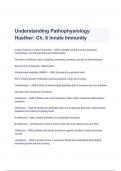
-
Understanding Pathophysiology Chapter 6 ( Innate Immunity) Questions & Answers (A+ GRADED)
- Exam (elaborations) • 14 pages • 2023
- Available in package deal
-
- $6.99
- + learn more
Understanding Pathophysiology Chapter 6 ( Innate Immunity) Questions & Answers (A+ GRADED)

-
NR507 Final exam Study Guide1.
- Exam (elaborations) • 40 pages • 2024
-
- $20.09
- + learn more
NR507 Final exam Study Guide1. Chapters 1-5, 11-14, 16-20, 21-25, 27-3-33, 34-39, 40-47 1. Types of immunity-e.g. innate, active, etc (ch 7 ,191) Innate immunity includes two lines of defense: natural barriers and inflammation Natural barriers are physical, mechanical, and biochemical barriers at the body’s surfaces and are in place at birth to prevent damage by substances in the environment and thwart infection by pathogenic microorganisms. the natural epithelial barrier and infla...
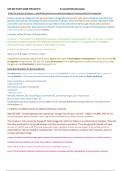
-
Advanced Pathophysiology NSG 530 STUDY GUIDE FOR QUIZ #1
- Exam (elaborations) • 11 pages • 2024
- Available in package deal
-
- $11.00
- + learn more
Study the process of meiosis – specifically what occurs when homologous chromosomes fail to separate Human cell can be categorized into gametes (Sperm & egg cells) and somatic cells, which include all cells other than gametes. Each somatic cell nucleus has 46 chromosomes in 23 pairs. These are diploid cells, and the individual’s father and mother each donate on chromosome per pair. New somatic cells are formed through mitosis and cytokinesis. Gametes are haploid cells: they have only 1 mem...
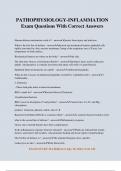
-
PATHOPHYSIOLOGY-INFLAMMATION Exam Questions With Correct Answers
- Exam (elaborations) • 7 pages • 2024
-
- $11.49
- + learn more
PATHOPHYSIOLOGY-INFLAMMATION Exam Questions With Correct Answers Human defense mechanisms work to? - answerprotect from injury and infection What is the first line of defense - answerphysical and mechanical barriers-epithelial cells tightly associated in: skin, mucous membrane, lining of the respiratory tract, GI tract, low temperature on body surface. Biochemical barriers are where on the body? - answerthe skin. The skin does what as a biochemical barrier? - answerproduces lactic acid in...
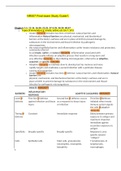
-
NR507 Final exam Study Guide1.
- Exam (elaborations) • 40 pages • 2023
-
- $17.29
- + learn more
NR507 Final exam Study Guide1. Chapters 1-5, 11-14, 16-20, 21-25, 27-3-33, 34-39, 40-47 1. Types of immunity-e.g. innate, active, etc (ch 7 ,191) ◦ Innate immunity includes two lines of defense: natural barriers and inflammation Natural barriers are physical, mechanical, and biochemical barriers at the body’s surfaces and are in place at birth to prevent damage by substances in the environment and thwart infection by pathogenic microorganisms. ◦ the natural ep...
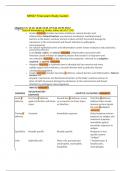
-
NR507 Final exam Study Guide1.
- Exam (elaborations) • 40 pages • 2024
-
- $17.99
- + learn more
NR507 Final exam Study Guide1. Chapters 1-5, 11-14, 16-20, 21-25, 27-3-33, 34-39, 40-47 1. Types of immunity-e.g. innate, active, etc (ch 7 ,191) Innate immunity includes two lines of defense: natural barriers and inflammation Natural barriers are physical, mechanical, and biochemical barriers at the body’s surfaces and are in place at birth to prevent damage by substances in the environment and thwart infection by pathogenic microorganisms. the natural epithelial barrier and infla...
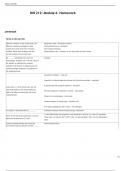
-
BIO 212: Module 6- Homework Terms in this set (74) Different locations of the human body use different resistance strategies to help protect the human host from microbial invaders. Match each strategy with the correct location in the human host.
- Exam (elaborations) • 8 pages • 2024
- Available in package deal
-
- $6.99
- + learn more
BIO 212: Module 6- Homework Terms in this set (74) Different locations of the human body use different resistance strategies to help protect the human host from microbial invaders. Match each strategy with the correct location in the human host. Respiratory tract - Mucociliary system. Gastrointestinal tract - Peristalsis. Skin- Sodium Chloride. Genitourinary tract - presence of uric acid, fatty acid and mucins An presenting cell, such as a macrophage, dendritic cell, or B ce...

How much did you already spend on Stuvia? Imagine there are plenty more of you out there paying for study notes, but this time YOU are the seller. Ka-ching! Discover all about earning on Stuvia


